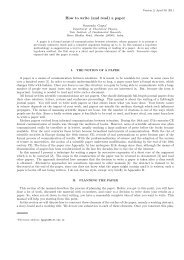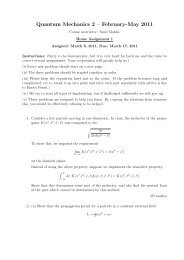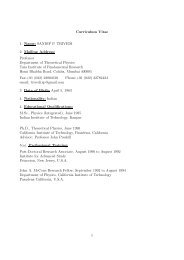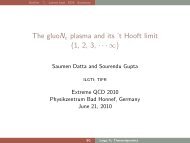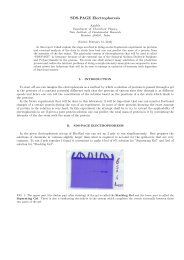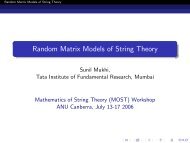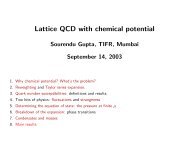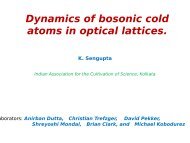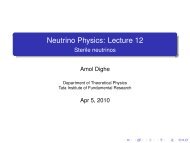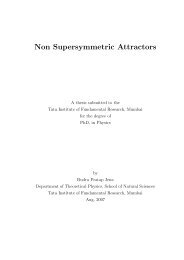Hot Stuff - Department of Theoretical Physics - Tata Institute of ...
Hot Stuff - Department of Theoretical Physics - Tata Institute of ...
Hot Stuff - Department of Theoretical Physics - Tata Institute of ...
Create successful ePaper yourself
Turn your PDF publications into a flip-book with our unique Google optimized e-Paper software.
PHYSICS NEWS<br />
was required to bind the nucleus<br />
into a stable entity. This was called<br />
the strong force.<br />
A detailed understanding <strong>of</strong> the<br />
spectrum <strong>of</strong> hydrogen showed that<br />
the electron and the proton interacted<br />
only by the electromagnetic forces.<br />
So clearly all matter in the universe<br />
was divided into kinds which saw<br />
the strong forces (these are called<br />
hadrons) and others which did not<br />
(these are called leptons). Half a<br />
century <strong>of</strong> discoveries which followed<br />
only deepened the mystery. So many<br />
more hadrons were observed that it<br />
became more and more unlikely that<br />
they are all elementary constituents<br />
<strong>of</strong> matter. At the same time all<br />
attempts at creating a theoretical<br />
model <strong>of</strong> these particles, considered<br />
as elementary, failed. In 1961 the<br />
first breakthrough came with the<br />
invention <strong>of</strong> the “quark model” by<br />
Gell-Mann [1]. This hypothesized<br />
that the elementary constituents <strong>of</strong><br />
strongly interacting matter were new<br />
entities called quarks. In terms <strong>of</strong><br />
these quarks it was possible to build<br />
something like a periodic table <strong>of</strong><br />
hadrons. The model predicted new<br />
hadrons, and was vindicated when<br />
they were found.<br />
Within a decade a relativistic quantum<br />
field theory <strong>of</strong> strong interactions had<br />
been written and technical difficulties<br />
involved in working with it largely<br />
solved. In doing this it was discovered<br />
that this theory, which was called<br />
Quantum Chromo-Dynamics (QCD),<br />
had an intrinsic length scale (which<br />
is about a femto meter). Strangely,<br />
the theory predicted that at distances<br />
much shorter than this scale, the<br />
strong interactions were rather weak<br />
[2]. Experiments soon verified the<br />
quantitative theory <strong>of</strong> the paradoxically<br />
weak strong interactions. The physics<br />
<strong>of</strong> long distances, where the strong<br />
inter- actions are strong required a<br />
reformulation <strong>of</strong> quantum field theory.<br />
Even after this radical invention it<br />
turned out that supercomputers were<br />
needed to make predictions. Since this<br />
forms the core <strong>of</strong> the method used in<br />
the description <strong>of</strong> the hot stuff at the<br />
beginning <strong>of</strong> time, we will return to<br />
this later.<br />
The strong interactions turn out to<br />
be the hardest theoretical and experimental<br />
challenge in physics until<br />
now. They are understood adequately<br />
enough for people to work with, but<br />
not enough to be considered solved<br />
and done with. At the end <strong>of</strong> a century<br />
about 30 Nobel prizes, to more than<br />
50 people, have been awarded for the<br />
strong interactions alone; the most<br />
recent was in 2010. This makes it the<br />
most awarded field in physics — a<br />
good indication <strong>of</strong> the continuing<br />
interest in the subject. Today it stands<br />
as the hardest part <strong>of</strong> the Standard<br />
Model <strong>of</strong> particle physics: a theory<br />
now verified through the recent<br />
discovery <strong>of</strong> the Higgs boson in the<br />
Large Hadron Collider (LHC) in<br />
CERN, and ready for application to<br />
the problem <strong>of</strong> the early evolution <strong>of</strong><br />
the universe.<br />
In order to have any confidence in our<br />
ability to do this, one has to design<br />
experiments to test the predictions<br />
<strong>of</strong> quantum field theory at high<br />
temperature. This is where the strong<br />
interactions come in. It turns out that<br />
the easiest way to produce hot matter<br />
is to bang heavy nuclei together in<br />
a high energy collider. The kinetic<br />
energy is converted to the thermal<br />
energy <strong>of</strong> a fireball which expands and<br />
cools, roughly in the same way that the<br />
universe did. These little bangs are full<br />
<strong>of</strong> strongly interacting matter.<br />
As a result, although QCD is the<br />
hardest part <strong>of</strong> the Standard Model,<br />
it turns out to be the most relevant at<br />
the present stage <strong>of</strong> testing our notions<br />
about the universe in its infancy.<br />
3 Supercomputing in<br />
quantum field theory<br />
When interactions are weak, the<br />
usual method <strong>of</strong> computation in any<br />
quantum theory is by developing<br />
a perturbation series. This works<br />
beautifully in the quantum theory <strong>of</strong><br />
electrodynamics, making it the most<br />
precisely tested physical theory <strong>of</strong> all<br />
times. However, this method is not<br />
available to us for strong interactions.<br />
Instead we rely on a reformulation<br />
which rests on two legs — the path<br />
integral method <strong>of</strong> Feynman and the<br />
grand synthesis <strong>of</strong> Wilson.<br />
The origin <strong>of</strong> quantum mechanics<br />
and wave-particle duality is seen in<br />
the two-slit interference experiment.<br />
A quantum particle, such as an<br />
electron, is described by a probability<br />
amplitude. When an electron<br />
impinges on a screen with two<br />
slits then it goes through both; the<br />
amplitudes <strong>of</strong> it taking either path<br />
have to be added. A detector placed on<br />
the other side <strong>of</strong> the screen can detect<br />
the electron at some position with a<br />
probability proportional to the square<br />
<strong>of</strong> the summed amplitude. This gives<br />
rise to the usual interference patterns.<br />
If a stream <strong>of</strong> electrons is sent through<br />
the apparatus then the detector<br />
sees more electrons in the regions<br />
where the interference maxima are,<br />
and less where there is destructive<br />
interference. This much was known<br />
from the 1920s. Feynman’s insight in<br />
the 1940s was that the number <strong>of</strong> slits<br />
could be increased indefinitely, and<br />
all the different paths that the particle<br />
could take would still interfere. In<br />
fact, the screen could be removed<br />
altogether and the resultant infinity <strong>of</strong><br />
paths would still interfere. Therefore<br />
the amplitude <strong>of</strong> a quantum particle<br />
to travel from the position x i<br />
at time<br />
t i<br />
to a position x f<br />
at time t f<br />
would be<br />
the sum (integral) <strong>of</strong> the amplitudes<br />
for all possible paths [3].<br />
An interesting duality was noticed in<br />
quantum mechanics since its beginning.<br />
Time evolution in quantum<br />
mechanics involves the unitary<br />
operator exp (iHt) where H is the<br />
Hamiltonian operator <strong>of</strong> the system<br />
and t is the time. At the same time,<br />
M[MeV]<br />
2000<br />
1500<br />
1000<br />
500<br />
0<br />
p<br />
K<br />
r K*<br />
S X<br />
L<br />
N<br />
Figure 1: A comparison <strong>of</strong> experimentally<br />
determined masses <strong>of</strong> hadrons<br />
with those predicted by QCD. Three<br />
parameters <strong>of</strong> the theory are adjusted<br />
by input <strong>of</strong> the masses <strong>of</strong> the π, K and Σ.<br />
The remainder are predictions [5].<br />
D<br />
O<br />
X*<br />
S*<br />
experiment<br />
width<br />
input<br />
QCD<br />
2






